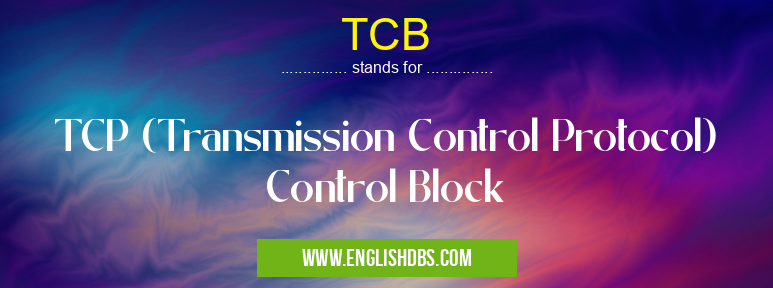What does TCB mean in NETWORKING
TCB stands for Transmission Control Protocol (TCP) Control Block. It is one of the most widely used protocols in computer networking to enable two-way communication between two devices. It is a type of software that helps in reliable, orderly and error-free delivery of data packets across the network.

TCB meaning in Networking in Computing
TCB mostly used in an acronym Networking in Category Computing that means TCP (Transmission Control Protocol) Control Block
Shorthand: TCB,
Full Form: TCP (Transmission Control Protocol) Control Block
For more information of "TCP (Transmission Control Protocol) Control Block", see the section below.
» Computing » Networking
Essential Questions and Answers on TCP (Transmission Control Protocol) Control Block in "COMPUTING»NETWORKING"
What is a TCP Control Block?
A Transmission Control Protocol (TCP) Control Block (TCB) is a data structure consisting of various pieces of information essential for the successful operation of the protocol. The TCB contains all the necessary information regarding a particular connection and helps keep track of the state of that connection. It’s responsible for managing how two computers interact, such as managing acknowledgements, sequence numbers, window size and other settings related to that connection.
How does a TCB work?
When two machines communicate via TCP, each one uses its own TCB. This data structure keeps tracks of relevant parameters within the communication session between these two machines. For example, it will remember the current sequence number, which is used to ensure packets arrive in the right order and with no duplicates. It also contains information about what bytes have already been acknowledged by both machines as having been received successfully.
Where is a TCB stored?
A TCB is typically stored in memory on either computer participating in a transmission session using TCP. In some systems, it may also be saved to disk when the current communication session ends so that it can be picked up again later if needed.
How often are changes made to a TCB?
Each time an acknowledgement is sent or received during the course of a TCP communication session, changes are made to the associated TCBs by both parties. These updates are made to ensure packet delivery reliability and accuracy for each side involved in the transmission.
Why might I need to modify my TCB?
Depending on your specific network environment or desired performance goals for your application, you may need to make adjustments or modifications to your TCP control block settings. This could include changing parameters such as congestion window size or retransmission timeout intervals as well as enabling certain features like selective acknowledgements (SACKs).
What type of information can be found in TCBs?
The contents of a Transmission Control Protocol (TCP) control block can vary depending on its purpose but typically includes fields such as IP source address and port numbers, destination address and port numbers, sequence number values, packet arrival time stamps and window sizes. Additional data such as acknowledgements flags may also be present depending on what kind of exchange is happening between peers over this protocol — for instance whether using source quench messages or allowing fast retransmits due to timeouts/duplicate acks etc.
How do I view my current TCP control blocks?
This depends on your system environment but if you're using Linux-based operating systems then most likely those details will be visible through tools like netstat or lsof commands which show active connections/sockets open at any given point in time and associated parameters values etc.
Can I create my own custom TCP control blocks?
Yes you can; however you should be aware that creating new entries from scratch implies manually doing all those steps required for setting up connections correctly including initial handshake establishment followed by all other necessary tasks until successful communication occurs between peers reliably without any issues along way.
Are there any security risks associated with modifying my own custom-made TCP control blocks?
If not done properly then yes modifying TCP control blocks could leave your system more vulnerable to attack by malicious actors who might exploit weaknesses present in these configurations if they become aware of them.
Final Words:
In conclusion, TCP Control Blocks play an essential role in networking today by providing a reliable way for applications to send and receive data across networks. Without them, most forms of digital communications we now rely on would be impossible or unreliable at best. Therefore it is important that system administrators ensure these structures are functioning correctly in order to maintain a healthy network environment where users can depend upon quick access times when sending or receiving files across any type of connection regardless if it’s wired or wireless.
TCB also stands for: |
|
| All stands for TCB |
